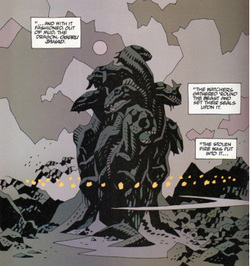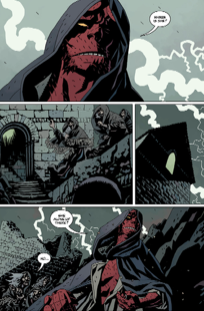
“WOK”. That is the sound of many a reader, experiencing Hellboy and the Mignolaverse for the first time - your skull-bone simply dislocating from your neck-bone, somersaulting through the air like some absurd acrobat and upon hitting the ground, rather a ‘plink-plonk’ of bouncing and a rolling to a halt. You didn’t expect it, you simply couldn’t have, but it hit you like a hundred tonne fist of doom yet so caressing in its embrace.
Sure, that introduction reads ridiculously, but what can be said that hasn’t already been said before about the great Mike Mignola? I remember my first taste of his artwork in the early 90’s, the original graphic novel Wolverine - The Jungle Adventure with Walt Simonson. I was not yet mature enough to fully understand nor appreciate the beauty within his lines, but one thing that I did realise was that this was something special to behold, and it remains one of my favourite stories today, visually and otherwise.

In March 1994, Mike began the journey on his creator-owned project, Hellboy, releasing it through Dark Horse Comics and scripted by John Byrne… Seed of Destruction. A slew of grimly toned Hellboy comics slowly followed, fully written and drawn by Mignola himself - and usually released as miniseries or through Dark Horse Presents. Mignola’s signature look had already been refined through the years and it wasn't until he started Hellboy, that the diamond began to shine.


The seeds had been planted, or rather, the Seed of Destruction, in multi-faceted ways from the very first issue. The ongoing mythology surrounding this world has always stemmed from the Lovecraftian-like entity, the Ogdru Jahad. Coupled with elements of various folklores from all over, the Mignolaverse unravels itself over the years, never forcefully. From the Secret History to the Caverns of Num Yabisc, the Vril power to Hecate, the Mignolaverse is a place for the small details. Details that build, intertwine and weave into a canvas that has no end. A canvas that starts from the middle and moves in outward motion, never between two points, but circular, spherical.

Comic book colourists can either define a title, or make a title definitive - which is why the great Dave Stewart has come to command my absolute respect and admiration. GARGANTUAN, for a lack of an even larger descriptive word, is the amount of effort it would take to colour not just one, but a multitude of Hellboy related titles. In fact - all of them… on top of any other titles he may be working on at any given time. Where someone else would simply colour the ski es blue, he creates the air we breathe, where the grass is green, he forms a mass of rock and stone and the texture under our feet.

By 2001, the Hellboy title had concreted itself in comicdom, achieving multiple awards and by 2004 had warranted its very own feature film. 2001 also marked the year that Mignola pushed Hellboy deeper into its mythology, leaving the B.P.R.D. at the end of Conqueror Worm and leading into fan favourites The Third Wish and The Island.
2006 saw the first artist other than Mignola to draw a Hellboy issue - Richard Corben. Makoma was the first, but definitely not the last. Jason Shawn Alexander, P. Craig Russell and Kevin Nowlan, were featured in multiple stories, interpreting the Mignolaverse in their own styles.

As would be expected from such a diverse world, the first of serialised spinoffs began with B.P.R.D., and subsequently Abe Sapien, Lobster Johnson, Sledgehammer 44 and Sir Edward Grey, Witchfinder.
The B.P.R.D. story arcs intertwined with events in the now separate Hellboy title, with the extremely talented Guy Davis, of Sandman Mystery Theatre fame, pencilling the majority of what is now known as the Plague Of Frogs cycle. Have you seen Pacific Rim? Yup, a lot of those creatures were designed by Davis. He can very well be the master of monster creation, among the many conceptualised in his run with B.P.R.D..This era also introduced many new characters we have become entranced with - Johann Kraus, Ben Daimio, Daryl the Wendigo and Panya.

We also have recurring artists like Tyler Crook and James Harren, usually on the B.P.R.D. title. Gabriel Bá and Fabio Moon, the wonder twins from Brazil, were introduced in the 1947 arc and subsequently Vampire - the first arc of a new miniseries. Cameron Stewart, Ben Stenbeck, Laurence Campbell, Tonci Zonjic, Jason LaTour and the other wonder twins, Max and Sebastian Fiumara - all share different characters and arcs between the several titles.

So here we are, 20 years later, through the ups and downs, the pains and pleasures, standing in the midst of Hell on Earth… and the future still holds endless possibilities. To the next 20 years and onwards!

 RSS Feed
RSS Feed
